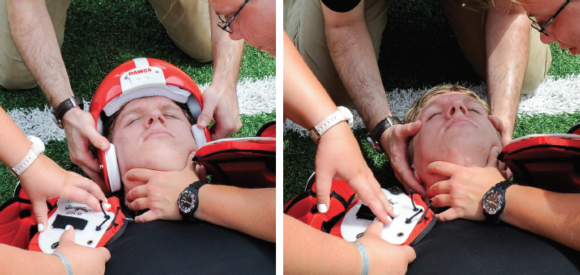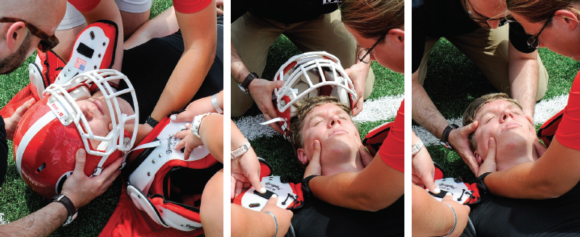If the decision has been made to remove the athlete’s equipment, the helmet and shoulder pads should be considered a unit and both be removed. Once the face mask has been removed, the helmet can be removed from the injured patient. Less motion in the cervical spine is generated when the face mask is removed from the football helmet prior to removing the helmet.95 Removal of the face mask allows for easier access to stabilize the cervical spine. However, circumstances may arise where the face mask cannot be removed. The sports medicine team should be prepared to remove the helmet under both conditions. Figures 9.24 and 9.25 demonstrate helmet removal with the face mask off and on, respectively. When working with lacrosse, hockey, or other types of helmets, different considerations may need to be made.96–98If time is of the essence, consider leaving the face mask on and simply removing the helmet with the face mask attached.

Figure 9.24 Helmet removal with no face mask.
Courtesy of University of Georgia.

Figure 9.25 Helmet removal with face mask.
Courtesy of University of Georgia.
Here are some tips for helmet removal:
- The chin strap should be cut away, because unsnapping the helmet may create unnecessary movement.
- Cheek pads should be removed from the helmet using a tongue depressor (or something similar) to snap the pad away from the inside of the helmet. However, the ability to remove the cheek pads varies based on the model of the helmet.
- If possible, air bladders in the helmet should be deflated to loosen the fit on the helmet on the patient’s head.
- Before the removing the helmet:
- Manual inline stabilization should be transferred from the rescuer at the patient’s head (rescuer 1) to rescuer 2, who can provide inline stabilization from the front of the patient.
- Rescuer 2 places 1 hand on the chin and the other hand on the posterior side of the patient’s neck (or as depicted in figure 9.26, on either side of the patient’s head).
- Rescuer 1, located at the head, grasps the side of the helmet while slightly spreading the cheek pad area on the helmet.
- Rescuer 1 then rotates the helmet forward while sliding the helmet off the patient’s head, being mindful to not place the head into flexion or extension.
- Once the helmet is removed, manual inline stabilization should be returned to rescuer 1 and padding (such as a folded towel) should be placed under the patient’s head.8 This padding will offset the height of the shoulder pads and prevent hyperextension, which can decrease space available for the cord.
- ATs and other rescue personnel should practice helmet removal with all types of helmets used at their venue.

Figure 9.26 Helmet removal: baseball catcher.
Courtesy of University of Georgia.